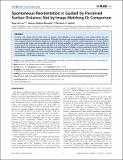Spontaneous Reorientation Is Guided by Perceived Surface Distance, Not by Image Matching Or Comparison
Author(s)
Lee, Sang Ah; Winkler-Rhoades, Nathan; Spelke, Elizabeth S.
DownloadLee-2012-Spontaneous Reorient.pdf (552.6Kb)
PUBLISHER_CC
Publisher with Creative Commons License
Creative Commons Attribution
Terms of use
Metadata
Show full item recordAbstract
Humans and animals recover their sense of position and orientation using properties of the surface layout, but the processes underlying this ability are disputed. Although behavioral and neurophysiological experiments on animals long have suggested that reorientation depends on representations of surface distance, recent experiments on young children join experimental studies and computational models of animal navigation to suggest that reorientation depends either on processing of any continuous perceptual variables or on matching of 2D, depthless images of the landscape. We tested the surface distance hypothesis against these alternatives through studies of children, using environments whose 3D shape and 2D image properties were arranged to enhance or cancel impressions of depth. In the absence of training, children reoriented by subtle differences in perceived surface distance under conditions that challenge current models of 2D-image matching or comparison processes. We provide evidence that children’s spontaneous navigation depends on representations of 3D layout geometry.
Date issued
2012-12Department
Massachusetts Institute of Technology. Department of Brain and Cognitive SciencesJournal
PLoS ONE
Publisher
Public Library of Science
Citation
Lee, Sang Ah, Nathan Winkler-Rhoades, and Elizabeth S. Spelke. “Spontaneous Reorientation Is Guided by Perceived Surface Distance, Not by Image Matching Or Comparison.” Ed. Jochen Zeil. PLoS ONE 7.12 (2012).
Version: Final published version
ISSN
1932-6203